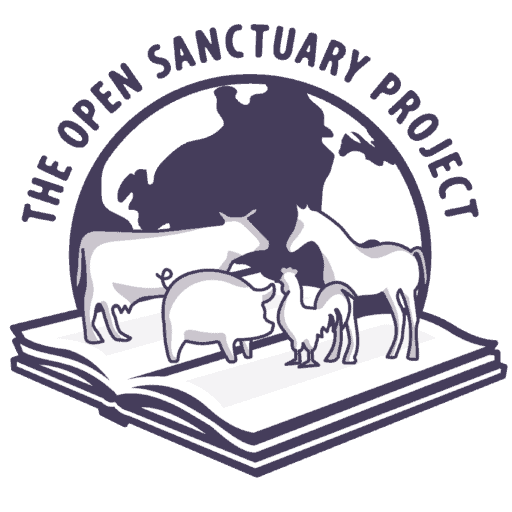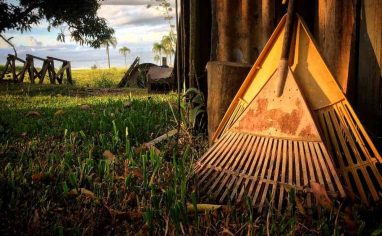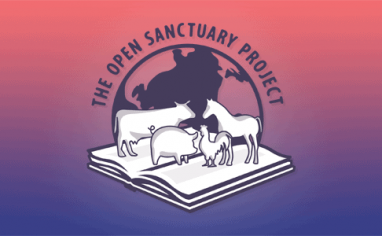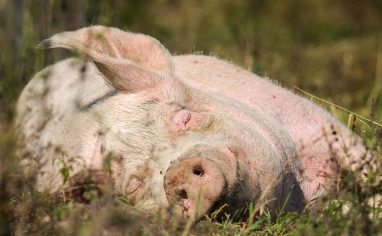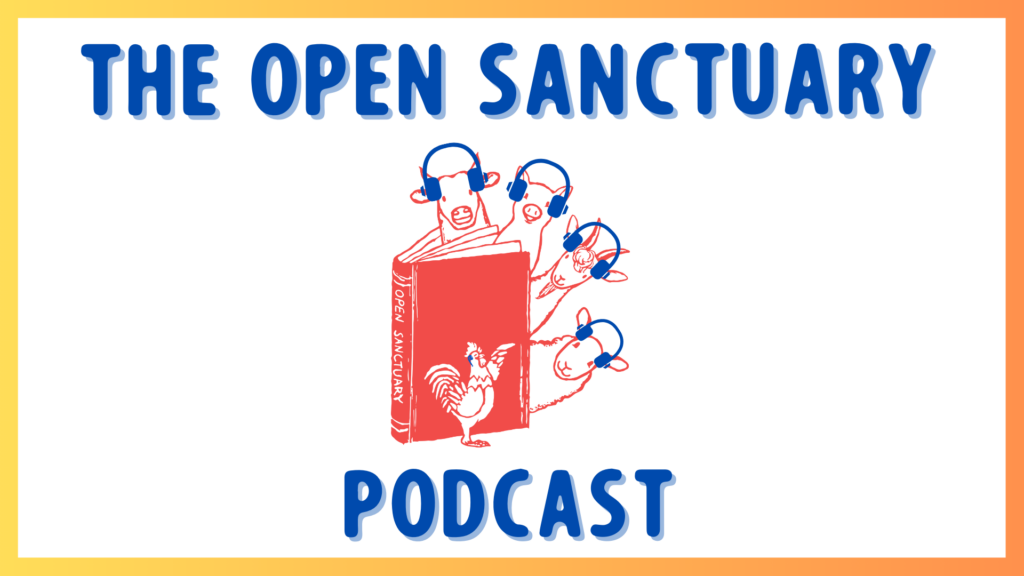
Subscribe To The Open Sanctuary Podcast
If you’d like to get the latest episodes of The Open Sanctuary Podcast, you can subscribe for free on all Podcast platforms, including Apple Podcasts and Spotify!
Episode Notes
Executive DirectorThe individual formally in charge of final decision making at an organization, who sometimes works closely with the organization’s Board of Directors. Sometimes a Founder is an Executive Director, especially early in a nonprofit’s growth stages. Mckenzee Griffler and NonprofitA non-governmental organization whose primary purpose is something other than selling goods or services. Specialist Julia Magnus continue discussing animal sanctuary capacity. We review some of the many elements that play a role in determinations around capacity and discuss ways to make it easier for your organization and team when capacity limitations dictate that you say “no,” and discuss other ways your organization can help even when you must decline a rescue request. We also discuss the concept of the “moral remainder” and how you and your team can address challenging emotions when they arise. Please be forewarned that there will be discussions around animal rescueAn organization that helps secure animals from dangerous or unacceptable situations. As organizations, rescues may or may not have dedicated permanent infrastructure for housing animals. and some of the emotional and complex ethical decisions rescuers must make.
—
This Episode’s Referenced Open Sanctuary Project Resources:
Determining Your Animal Sanctuary’s Capacity For Responsible Care
What Does “Philosophy Of Care” Mean At The Open Sanctuary Project?
The Challenges Of Responsible Animal Rescue
25 Questions To Help Guide Responsible Intake Decisions At Your Animal Sanctuary
How To Create An Effective Rescue Policy For Your Animal Sanctuary
Managing Cruelty, Seizure, And Escapee Cases At Your Sanctuary Or Rescue
Building And Maintaining A Good Relationship Between Your Animal Sanctuary And Veterinarians
Considering Alternative Living Arrangements In Response To A Health Concern
The Importance Of Regular Health Checks For Residents At Your Animal Sanctuary
Saying Goodbye With Respect and Safety At Your Animal Sanctuary
Estimating Species Lifetime Care Costs At Your Animal Sanctuary
Creating An Effective Set Of Contingency Plans For Your Animal Sanctuary
Cultivating Resilience At Your Animal Organization In The Face Of Inflation
Understanding Your Animal Sanctuary’s Zoning Rights & Restrictions
Fostering Positive Relationships Between Animal Sanctuaries
A Forever Home? Adoption Program Considerations For Animal Sanctuaries
Microsanctuary Resource Center
Episode Transcript (Auto-GeneratedThe following content was transcribed through an automated process and may contain transcription errors or misspellings.)
Julia Magnus: Greetings, sanctuary friends and family. I’m Julia Magnus, the nonprofit specialist at the Open Sanctuary Project.
Mckenzee Griffler: And I’m Mckenzee Griffler, and I am the executive director of the Open Sanctuary Project, and we are here to continue our discussion about capacity.
Julia Magnus: So in our last episode, we talked about how hard it is to define what capacity is for animal sanctuaries and how it’s dependent on a number of factors. So instead of having a hard and fast ideal number of residents that a sanctuary should have, we actually recommend looking at a number of different factors. We also talked about the importance of the sanctuary carefully monitoring and actively discussing with all team members the question of capacity and the direct link between having those regular meetings between the whole team to talk about these questions and the long-term sustainability of your sanctuary. There are maybe a few things that sanctuaries should probably consider closely and regularly as a full team: those being mission, vision, your philosophy of care, and, you know, capacity being another one. It might be worth maybe quickly mentioning the elements that you would want to consider carefully when you’re having those kinds of discussions as a team.
Mckenzee Griffler: Oh yeah, definitely. So, as a refresher from our last podcast episode on the variables of capacity, I think it’s pretty important that we think about it as a holistic measure of a number of things. And at Open Sanctuary, we choose to break them down by spatial capacity, which is both the overall amount of space you have in your sanctuary, as well as individual living spaces that are appropriate by species, and the ability to change up living spaces due to social changes or health changes or quarantine capacity. Because hopefully listeners of this podcast know how important it is to have a species-appropriate separate space to bring in intakes to keep everyone safe. Personnel capacity. So regardless of whether that’s just you as the sole caregiverSomeone who provides daily care, specifically for animal residents at an animal sanctuary, shelter, or rescue. or if you have a caregiving staff of volunteers and staff, how much are they doing in a day and could they handle additional residents in a way that would feel safe and sustainable for everybody? Your financial capacity, not just the overall financial health of your organization, but also what would added cost for additional residents look like by species, as well as thinking about what kind of buffer you might need in case of unexpected veterinary expenses. Regulatory capacity. Are you properly zoned to be able to responsibly take in additional residents of certain species or, in some cases, certain sexes of certain species? And just being well aware of the laws that govern in your sanctuary’s area. And emergency response capacity. How could you safely get your residents away from a situation that might be happening at your organization, be that a weather event or something infrastructure-wise happens? Basically, just will you be able to manage if something happens that you need to very quickly move a lot of your residents? So, there are probably other variables of capacity that we could think about. But we think that’s a really great place to start, especially when you’re thinking about both thinking about your current capacity, because these can each change week by week or month by month or quarter by quarter.
Julia Magnus: And then also, if we’re thinking about increasing your population, say with a rescue or taking on a surrenderThe act of transferring guardianship of an animal to a person or organization, especially via legal contract., how well could you absorb that into your capacity variables without stretching any of them a little bit too thin? In case you’re worried about keeping track of all those things, we do have a resource which is titled “Determining Your Animal Sanctuary’s Capacity for Responsible Care” that’s on the site. And we also got into some more detail about each of those elements last week on our prior podcast on this subject. Take a look at our show notes because there are a lot of resources that are linked that are going to be helpful in sort of engaging your staff, your whole team together to address these questions. So in addition to those factors, there’s also a question of a rescue policy, right? Which is how you as a team could maybe create a protocol that you can run through together when you’re considering new decisions for intakes, considering embarking on a rescue, potentially considering if you’re approached by animal control or law enforcement, whether you should engage in a cruelty seizure or escape case or a bust, or something of that ilk. Again, all those resources are linked in the show notes and hopefully can help fuel a healthy discussion at your sanctuary on all of the elements that you’ll need to consider. But one thing that comes up, and every sanctuary at a certain point will encounter it, and it’s a very tricky one, and that’s the question of how you say no. I do rescue work myself, and I find having to say no every single day, virtually, which is pretty heartbreaking. So, we feel your pain when it comes to these questions because it’s very hard to say no when you know that the individual in question may not have any other option. So, when you’re thinking about saying no in light of your capacity, what do you think some tips might be in helping your team have that discussion, come to that conclusion? What kind of things can sanctuaries do that might make it easier for the public to understand why you might need to say no? How can we do that compassionately and in a way that educates folks?
Mckenzee Griffler: This is probably one of, if not the most challenging aspect of sanctuary, is just that for the vast majority of sanctuaries and rescues, the need far outstrips every individual organization’s ability to meet the need for rescue. And I just want to underscore that we understand that this is an impossible thing to do to say no and recognize that it is very challenging on whoever is involved in making that decision to come to that conclusion, and it can really wear you down because obviously you don’t come into this work to say no to people that need help. I do think that a great place to start, which Julia alluded to earlier, is to have a rescue policy. And it’s not something that needs to necessarily be public facing, although you certainly could share a version of it if you wanted to. But having a framework that might help your team share the burden, if you have a team, or even just trusted members that you could talk it through to really understand what factors lead you to be able to say yes to an additional rescue and intake, and what might be more challenging to say yes to. And we have one source that I think is really helpful, which is “25 Questions to Help Facilitate Responsible Rescue,” which could be a really good guideline just to take a look at. In addition to the “25 Questions to Help Guide Rescue,” we also have a great resource called “The Challenges of Responsible Animal Rescue,” which I would highly recommend that if you are new to this work or still trying to find your footing around the question of rescue. I think that’s a really useful document for helping to facilitate conversations both with your staff about rescue, as well as with whoever might be involved in the local rescue community around you. So you can have a good understanding of what challenges might be involved, how to have productive dialogues about rescue, and to ensure that everyone is feeling understood and seen in this very challenging facet of caring for animals and trying to create a better future for animals. Yeah, that responsible rescue resource, I really am a huge fan of because I don’t exactly remember when we updated it, but we did so as an entire team.
Mckenzee Griffler: And when we did it, we included some hypotheticals in that, which I think I personally really like. I like hypotheticals because you can imagine yourself in that situation. These are not based on any specific real life example, but the kinds of situations that sanctuaries and rescuers can encounter and do encounter regularly. And it includes, you know, a situation where someone said no, and it includes, you know, the tips for rescuers who are trying to surrender potentially, and tips for those who are receiving requests, and ways that they both might be able to communicate and collaborate better and educate each other better. And so I think it’s a really helpful one when it comes to just preparing yourself for this world. Yeah. And I think there are some things that sanctuaries can do to ease the burden of people who are being put in an organizational position to have to decide to say no to a rescue in order to maintain the sustainability of their organization. I think a great place to start would be to have a public-facing statement on social media that might help explain your sanctuary’s current capacity status and what led you to that decision. Not that you have to have 100% transparency on every single detail, but you can create a statement that might help the public come to an understanding of why you might not be saying yes to certain situations, certain species. I think it can help really both explain to the public what your current status is, as well as maybe create some educational guidance around your own responsible practices that you’re taking in order to maximize the likelihood that all of your residents are going to live a long peaceful life as you promised them. That’s something that we’ve done as a group in rescue where, for example, we find our capacity limited suddenly because one of our current residents or a foster or a recent rescue had significant needs for veterinary care, significant to the point where most of our energy would be involved shuttling the individual back and forth to the vet. All our funds at that point are spent on that.
Mckenzee Griffler: And as a small group, it’s possible to highlight these stories of these beings who, through no fault of their own, found themselves in this situation, and we stepped in. And their care—the care of the existing foster, existing resident—has to come first before anything else. I will say sometimes you will still get, even if you do have these public-facing social media statements on your current state of capacity, you will still get requests. Sometimes people don’t read them, or they figure, “We’ll try anyway. We’ll just ask anyway.” In cases where you’re getting requests regardless of what you’re saying publicly, one tool that we’ve found helpful is the auto-reply, which, you know, when somebody messages you on socials or somebody sends you an email, you have this reply ready, which you can change at any given point in time to reflect what your current status is, but explains where you’re at. If you were saying you’re currently closed for intake, you would lead with that. You could explain why if you want.
Julia Magnus: And since I work mostly with roosters, we’ll say things like, “You know, if you are writing to surrender a rooster, please be aware of the plight of roosters,” and we link to OSP resources, which at that point people can peruse and they can learn more from that. So it’s an educational opportunity. We do try to put it pretty diplomatically and kindly because we know that folks messaging may really love their rooster and they really do want a good home, but we simply can’t provide that at this time. But we do want them to take the chance to learn more about why this is such a major issue. So it’s not like, “We’re closed for intake, goodbye.” It’s, “We’re closed for intake. This is the current state of our operations, and this is what you should know.” And I think actually there’s also something that we’ve talked about in the past in another resource, which is collaboration and cooperation with other animal sanctuaries. In some cases, you may have a relationship with other organizations where you could potentially refer requests to them, but please don’t do that without asking them first and checking with them because we’ve had people just refer to us and we don’t have capacity.
Julia Magnus: And then it’s just a whole other explanation that you have to go into, and it’s tough. And it’s like, “Well, we’re at capacity.” “Well, this organization said you have room.” It’s, “Well, no, we actually don’t.” And it would have been nice for them to ask us first.
Mckenzee Griffler: Yeah. And you know, we do have an entire resource on fostering positive relationships between sanctuaries. And we definitely underscore this point that if you’d like to create that relationship where you can refer and take rescue requests, that’s wonderful. But that is an ongoing dialogue, and it can create a lot of friction between organizations if you just create an assumption, or create an assumption in the mind of the public that this organization can just handle whatever request you might be declining. And I also just want to underscore that we understand that you can create the most public-facing guidance or explanation of what goes on with your organization and why you might not be able to facilitate certain requests, and people ignore those things. We at the Open Sanctuary Project are pretty transparent that we are not an animal sanctuary and we have no residents as an organization, and we get rescue requests. We get rescue requests weekly. And obviously, it’s a bit of a different scenario because we don’t have a sanctuary, but even we have to put these practices into action, or we have to practice these things ourselves because we recognize that people are coming to us with the same desire to create a better life for an animal, and we simply do not have the capacity to help in that regard. Yeah, those are always hard because, you know, in theory, anybody who finds the Open Sanctuary site probably has some interest in the compassionate care of animals, but there’s just no way that we can take rescue requests or facilitate that. It’s just not our mission and vision, and thank goodness, because that would be a lot for day-job extracurriculars. But yeah, there may also come a time where a particular request comes in, and you feel you can’t say no. Those may be situations where the opportunity to rescue a potential resident, for whatever reason, will take precedence over your concerns of limited capacity. Perhaps it’s a situation where you just know that this individual has significant medical needs. Now, let’s put aside the question of expanding your own capacity at this point. That’s a whole other discussion, and that’s something that I think we’re probably going to do in a Part Three of this podcast. But aside from expanding your own capacity, there are some other ways that you could help in such situations
Julia Magnus: Do you want to start to run through that list, Mckenzee? Like the options that you might be able to offer or assistance you might be able to offer?
Mckenzee Griffler: Yeah, absolutely. One way that you might be able to help in some capacity with a request that you really don’t have the capacity to take on long-term is you could offer to assist with transport. And that could either be from wherever the animal is to a veterinary clinic, or help to transport within your region, or even in a long-distance transportation to another organization or individual that’s willing to help out. You can help gather donations for this rescue. And this one can be a little bit trickier because you really want to have good communication with your audience about what the situation is, who’s involved, where the donations are going to, what they’re going to be facilitating, and also helping your audience recognize that you are not the long-term home of this resident, and maybe making sure to point out any inter-organizational collaborations going on. Make sure to give credit where credit’s due, and really make sure that folks who support this resident or this rescue have an understanding of where they’re going and how to continue supporting them. You could offer a temporary foster, or you could even facilitate a temporary quarantine. Not that this would necessarily mean that at their final destination they don’t require quarantine, because we always say that if you’re having a resident come in from anywhere, even if it’s from a different sanctuary or different quarantine, you still want to think about quarantining. Really consider it because it is really critical for any unseen issues that might affect your existing residents. But you could temporarily foster this resident for a length of time with the understanding that this is not going to be their forever home necessarily. You, Julia, what are some other things that they can do?
Julia Magnus: Well, you know, there are other kinds of practices you could try. For example, say you’ve got somebody who is allowed to have a rooster, wants to have the rooster, but their neighbors are complaining, so they feel like they’re being compelled to surrender this rooster. You could potentially assist them with whatever infrastructure might be helpful and educational advice that might be helpful to help them retain their roosters. So, for example, you could educate them on how roosters could be kept indoors overnight and on the housing, and maybe even provide them with the kind of housing that’s appropriate for that rooster to stay indoors overnight until a reasonable time in the morning where the neighbors are going to be okay with crows. So, I would call those kinds of things mutual aid practices. Those go a long way to broadening your community as a sanctuary as well, and creating and fostering goodwill among communities. If you have close relationships with other organizations, one thing you can also do is share your list of good adopters. I’ve definitely seen this go both ways. I’ve seen organizations who are very protective of their adopter list, which is understandable because most, especially with roosters, those homes are hard to find. But I’ve also seen organizations who will liberally share their adopters list when they perceive that there’s a need. And that’s a huge help because if you have, you know, Sanctuary A in state one, and then Sanctuary B in state two, they’re not going to have the same list. But interstate transport between adopters’ shared lists is possible. And extremely helpful if, say, Sanctuary A suddenly has to rescue 20 birds or something, and Sanctuary B, their adopter list has some capacity, they have some people who are looking to adopt more birds. And similarly, you could also share volunteers. So Sanctuary A in state one has a lot of volunteers with a lot of energy and a lot of desire to help, and Sanctuary B hits a situation where, say, they had a sudden storm that destroys infrastructure. Sanctuary A could ask, “Hey, could our volunteer team, any of you who are willing, travel out to Sanctuary B and assist them for a day?” And those kinds of things can really go a long way to organizations supporting each other, building capacity together, and building a stronger community overall.
Mckenzee Griffler: Absolutely. And I love that idea of sharing knowledge or even sharing your own volunteer base in order to build up the capacity or create a suitable forever home elsewhere. I would say that something that we talk about in the “Fostering Positive Relationships” resource is generally, in our observation, it’s best to check in first and make sure that this is wanted, and say, “Hey, you know, we have a way that we might facilitate doing this, or we might have this way that we might suggest,” and check in first and make sure that that feedback or that information is desired or they’re open to it before you just, you know, even if you have the best of intentions about sharing information about any topic regarding capacity or animal care with a different organization, you just don’t necessarily want to come off as kind of imposing the way that you do things over, you know, another organization that might still be learning or they might have their own reasons for why they do things differently. Which is why we always suggest that you can always send another organization. You could say, “Hey, I found this great thing on Open Sanctuary, a neutral ground, and we’d be happy to, you know, our resources are publicly available and are great tools to create a dialogue about different ways of doing things without seeming like you’re trying to impose how you want to do something to another organization.”
Julia Magnus: Mhm. Totally, totally agree with that. I think that has come in handy for me so many times with different projects that I’ve worked on with other organizations, and it’s like, “Hey, what do you think about this here thing that OSP made?” And they’re like, “Hey, this here thing looks pretty good.” So, yeah, it’s definitely great. And also, I think we should also underscore again, and in most of these situations, if you’re going to engage in fundraising or any kind of social media posts about these rescues where you may not be taking on full responsibility for the individuals involved, you’re going to want to be accurate and transparent in your socials in general with any statements you make to the public. And to that end, we also threw in the “Accuracy and Transparency” resource into the show notes.
Mckenzee Griffler: And finally, one way that I think this might be a bit of a sneak peek for expanding your capacity, but one thing to start thinking about if you haven’t thought about it before, is whether your organization wants to create a long-term adoption program. This is one way that you can say yes a little bit more often without having to necessarily plan for an entire long life of capacity per resident. Of course, if you don’t find a suitable home, you also are still saying yes to that resident. And of course, you have to consider whether if an adoption isn’t a good fit with a suitable home, are you going to say yes again to that resident since you did promise them sanctuary? These are all questions that we discuss in our adoption program resources, which are quite lengthy. They include things like adoption contracts, pros and cons of adoption programs for sanctuaries, and sample adoption applications. That is probably another three podcasts in itself, so I’m not going to get into it, but that can be a way if you’re finding yourself saying no many, many times, and you’d like to be able to say yes a few more times to expand out your capacity a little bit. Of course, I will just preview, whenever we get into that podcast, running a responsible adoption program is going to cut into your personnel’s capacity a little bit, because that in itself is a big job. One thing maybe we could take away from this discussion on the variables of capacity is everything takes capacity in sanctuary. Everything will in some way affect these different variables. There is really no way of just getting additional capacity without putting in some effort in some other variable of capacity. And that is the joy and the challenge of sanctuary. Right.
Mckenzee Griffler: Yes. Yes. I’m so glad you mentioned that because even just like, “Okay, I have a 501(c)(3) now, people will give me money.” Well, you’ve got to acknowledge those donations now. You’ve got to thank people. You know, you have to consider what kind of donations you’re getting and how you acknowledge them. Got to do your 990, yep, you’ve got to do your 990. You know, all of a sudden, “Oh, I’ve got a bunch of people who are interested volunteers, yay!” Okay, well, you’ve got to train those volunteers now. Make sure that you put in place safety considerations for them. So, as much as anything comes with great benefits, it also will come with costs that you’ll have to consider carefully and devote careful consideration to. So, I’m glad you mentioned that. The last thing that we wanted to talk about in this episode is something that I think we talk about a lot at the Open Sanctuary Project, and that is the idea of the moral remainder. And Julia, do you want to talk a little bit about that?
Julia Magnus: Sure. The resource where I think we addressed it carefully was at the end of the “Cruelty Cases, Seizures and Busts” resource. So the moral remainder, what is that? Right. Most of us in this world are familiar with at least some basic understanding of ethical philosophy around animals. And one school of thought is utilitarianism. So in utilitarianism, essentially what you’re trying to do is you’re trying to measure the good that will result from any given action and weigh it against the harmThe infliction of mental, emotional, and/or physical pain, suffering, or loss. Harm can occur intentionally or unintentionally and directly or indirectly. Someone can intentionally cause direct harm (e.g., punitively cutting a sheep's skin while shearing them) or unintentionally cause direct harm (e.g., your hand slips while shearing a sheep, causing an accidental wound on their skin). Likewise, someone can intentionally cause indirect harm (e.g., selling socks made from a sanctuary resident's wool and encouraging folks who purchase them to buy more products made from the wool of farmed sheep) or unintentionally cause indirect harm (e.g., selling socks made from a sanctuary resident's wool, which inadvertently perpetuates the idea that it is ok to commodify sheep for their wool). that might come from that action. And your goal is always to take the action that promotes the greatest good. Well, that seems pretty simple, right? It seems like it’s just sort of a fail. You put this on this side, this on the other. How does it, how does it fall? And then you do that thing. Except the problem is that there are very few actions that you can take when you’re making ethical decisions that don’t result in some kind of harm ultimately. So the idea of the moral remainder is essentially that even if you’ve chosen an action which promotes the greatest good that you can imagine, there’s still going to be some other side to it. Somebody who went missing, something that was lost in choosing that action. So for example, if you are participating in a rescue where there are 25 sheep in a hoarding situation, they’ve been neglected, your sanctuary has capacity to take five. You have to choose which five. Okay, so say your sanctuary has a special reputation for caring for disabled animals. So you choose the five disabled sheep in the group because you know that you can give them the best shot at life, but you don’t have necessarily control or say of what happens to the other sheep. And so those lives might be considered to be the moral remainder to your decision. And I would say a lot of utilitarians don’t consider the reality of coping with that moral remainder, the toll that it can take on people who are making those decisions, how hard it can be to look at them and know that you had to say no to those, even though you could say yes to these. And so I think when you have to say no, it’s important to acknowledge that every decision comes with a moral remainder, to give every member of the team who is involved in that decision-making process a chance to acknowledge and to grieve the moral remainder when it occurs, and to acknowledge as a team that this happened, that there were impacts, and it’s okay to feel bad about it. It’s okay if, even if you know the decision you made was the best one for the individuals involved and your organization, it may not always feel great. And it seems like it should, but it doesn’t always feel great because there’s that moral remainder. So giving people a chance to acknowledge, take ownership over that, and grieve it if they need to, is an important part of maintaining a team that’s honest with one another and themselves, and an organization that’s accountable for the decisions it makes.
Mckenzee Griffler: That is a heavy acknowledgment. And I think in this work, where so often we are trying to work against such a major cascading series of challenges in the world and trying to do our part to help those that are caught up in it and help prevent those scenarios in the future, I think it is so critical that we always think about the way that this work impacts us as caregivers, as those involved in making decisions in sanctuary and rescue, and really just being open and supportive with one another when these harder feelings come up and these harder realities present themselves. So, I really appreciate you explaining that, and I think it’s something that even if we don’t all have words for it, we’ve all experienced in this work.
Julia Magnus: Yeah. Yeah. I certainly have. And I think, you know, there is a certain, until I realized what a moral remainder was, there was a level of denial that I just lived with all the time. I just tried not to think about it. And that wasn’t particularly healthy. Now, we talk about it openly as a group, as a rescue group, and we take time. And I think it really helps build solidarity within the group. And it also helps us look forward too and learn more from the experiences we have. I think it’s an important part of community building and also it’s capacity building in a very deep sense because you’re building understandings within your team that you wouldn’t have if you didn’t address the moral remainder together. And you’re learning lessons that you can apply to future and figuring out how to go forward from that. Yeah. Well, I think we’re going to end it there on that light note, but…
Mckenzee Griffler: …time. I think we’ll probably have one more part in our capacity series in the near future talking about how we can think about both a safe buffer for each of these variables of capacity to ensure sanctuary stability, and also how you might be able to expand some of these capacity metrics. And there’s more than one way with each of these. It’s not necessarily just cut and dry. So, I’m excited to have that conversation with you.
Julia Magnus: Oh my goodness. So grateful to be working with you and with this amazing team so that we can do our very best to provide sanctuaries with the support that they need and to serve. And again, check out the resources in the show notes to learn more. And if you feel like supporting our work, check out our website. There’s a spot you can make donations, and we welcome them. And any feedback that you might have as well. And if you have any ideas for future episodes or questions for us, there’s a lot of ways you can get in touch. Easiest is at our website, opensanctuary.org/contact. And we’ll talk to you real soon.

Got A Podcast Idea? Contact Us!
If you have a topic or question you’d love to hear our staff address on The Open Sanctuary Podcast, please get in touch via our contact form!
